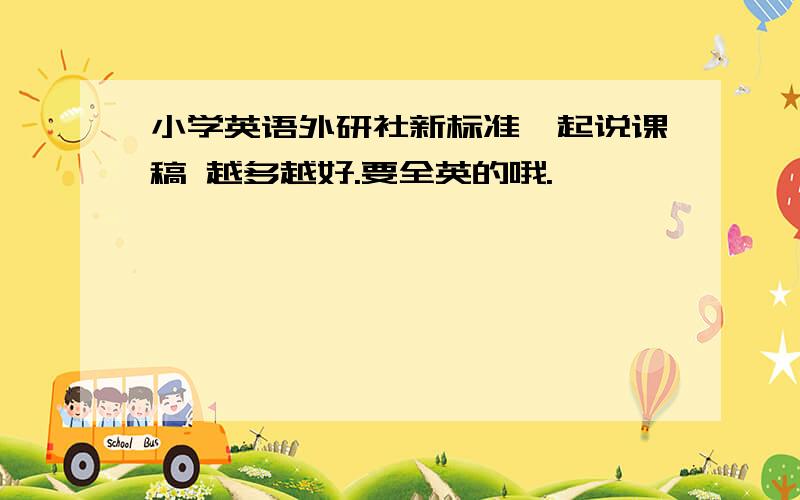小学英语外研社新标准一起说课稿 越多越好.要全英的哦.
来源:学生作业帮助网 编辑:作业帮 时间:2024/11/16 19:29:16

小学英语外研社新标准一起说课稿 越多越好.要全英的哦.
小学英语外研社新标准一起说课稿 越多越好.要全英的哦.
小学英语外研社新标准一起说课稿 越多越好.要全英的哦.
It’s my great honor to be here sharing my lesson with you.
The content of my lesson is《New Standard English 》Book4 Module8 Unit1 I was two. Then I’m going to talk about it through the following six aspects: teaching material, students, teaching aims, teaching points, teaching preparation and teaching process.
一、Teaching material
The topic of this module is “Changes”. The language function of this unit is throughing the photos of Lingling’s grandparents and her own to describe the things past with “was/were”. The main patterns “They were young.” and “I was two.” are close to Ss’ daily life. Therefore, they would show their great interests in this lesson and try to use what they have learnt in their real lives. By studying this unit, Ss can discuss the things that occurred in the past to themselves with “was/were”.
二、Students
The Ss in grade four have got some English foundations. They also have higher learning enthusiasm and lively personalities. As a result, the activities full of fun and relaxation are offered in order to let the Ss learn English more freely. Meanwhile, the abilities of observing and self-study , the habits of independent thinking and positive participation are fostered in the class.
三、Teaching aims
(一)Aims on the knowledge
1.The Ss can understand and speak the words: who, grandparents, then, me, hair, so.
2.The Ss can understand and speak the sentence patterns: They were young. I was two.
(二)Aims on the abilities
1.The Ss can read the dialogue fluently.
2.The Ss can communicate with “was/were” according to the photos.
(三)Aims on the emotion
Through the Ss’ comparison the old life with the new one, they will not only cherish the life nowadays, but also improve emotion between the families.
四、Teaching points
(一)Key points
1.The Ss can understand and speak the new words and the sentence patterns.
2.The Ss can describe the things past with “was/were”.
(二)Difficult points
1.The Ss know the usage and relationship between “am/is/are” and “was/ were”.
2.The Ss can discuss the real life with the sentence patterns freely and creatively.
五、Teaching preparation
Tape, recorder, photos, multimedia, cards, stickers.
六、Teaching process
Step 1 .Warming-up
1. Greetings
2. Enjoy the song “The family”.
3. Free talk
T: Here is a family photo. Let’s describe it.
In this photo, Father is … (choose the appropriate adjectives)
S: ….
T: Mother/Brother/Sister/Baby is…
…
[Design intent] The song can adjust the Ss’ thought, arouse their interest in learning English, let them enter the atmosphere of learning English quickly.The free talk can help them review the adjectives which are used to describe the personalities and characters.
Step 2.Presentation
1. Leading- in
T: Here is another family photo. Do you know who the baby is?
S: …
T: It’s me! ( Teach the word “me” at this moment.)
I was two, then. Now I am 30. (Show Ss the current photo.)
T: Our friend Lingling has got some photos, too. Do you want to have a look?
[Design intent] Through the new and old photos show, bring out the topic of the text smoothly and make a good preparation for the text learning.
2. Text
(1)Listen and try to find out the words they don’t know. Study them in groups. Then T consolidates the meaning of “who, grandparents, then, hair, so”.
(2)Listen read and underline the sentences with “was/were”.
T: What’s the difference between “am/is/are” and “was/ were”? (Explain it under the help of the photos.)
[Design intent] Through the listening and underlining, Ss can have the deeper understanding to the text. Explain the past tense appropriately and design the blackboard writing reasonably. Let Ss know the meaning and usage of “was/ were” clearly.
(3)Listen and read the dialogue again.
Step 3.Practice
1.Look, listen and guess.
Show Ss four pairs of pictures, choose the correct one after listening to T’s description.
2.Do Activity 3 on page 31. Discuss the answers in groups.
[Design intent] Through the activities, let Ss practice the sentence patterns step by step. Cultivate Ss' abilities of cooperation and participation by group-working.
Step 4 Consolidation
1.Enjoy the passage of the cartoon “The ugly duckling”. Discuss the changes of the little duckling according to the T’s reminder.
2. Show Ss some photos of new and old Yantai, let them realize the great changes of our life.
[Design intent] The cartoon can make Ss show more interests in learning English. Through the photos show, Ss will love and cherish the new life more.
Step 5 Summary
Ask Ss themselves to summarize what they have learnt today.
Step 6 Assignment
1.Listen and repeat the text.
2.Describe Ss’ own photos with the sentence patterns in groups and prepare to show in next class.
[Design intent] Making lots of listening and speaking exercise is able to train Ss’ comprehensive language abilities and strengthen their confidence. In addition, extending the knowledge in class to the real life effectively can finally achieve the purpose of communication using language.
Design of blackboard writing
Moduel 8 Changes
Unit 1 I was two.
(then) (now)
I was two, then. Now I am 30.
They were young, then. Now they are old.
She/He was…, then. Now she/he is….
采纳一下吧 谢谢